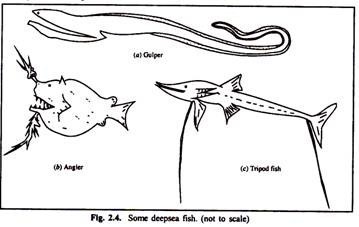Deep sea is characterized by a set of environmental conditions, which in turn determine the adaptations of deep-sea forms.
Of all the oceanic zones, light penetrates only into the euphotic zone; the remaining zones are aphotic or devoid of light (bathyal, abyssal and hadal zones).
The term hadal zone is used to designate the perpetually cold and dark supreme depths of the ocean.
It is characterized by high pressure, low temperature, absence of light, calmness of water, absence of phytoplankton and other producers, scarcity of food and resulting competition and soft bottom.
Apart from containing bacteria and perhaps fungi, the community of aphotic zones is characteristically animal. Because of lack of cues like light and temperature change, it was once thought that there was no seasonality in the deep sea, but this is not so. The amount of detritus coming into deeper waters depends on seasonal production cycles at the surface. Due to extreme pressure the bodies i deep-sea fish and other animals are very much compressed. Some bathypelagic fishes are economy’ designs showing reduction of bony skeletons except for their jaws and contain watery muscles.
In some of them e.g., angler fish (Melanocetus) and gulper eel (Eurypharynx) the water content is very high, about 95%. Even without gas-filled swim bladders, they are near neutral buoyancy. Their hearts are very small, they have very little red muscle and low haematocrit values.
Some deep-sea fishes exhibit greatly enlarged eyes or the so-called telescopic eyes, which are highly effective in visioning lights of very low intensity. In some deep-sea fishes the retina is composed of a number of tiers of rods, presumably arranged to absorb all the limited light that enters the eye (Nicol, 1989). In some other deep-sea fishes, eyes are very small as they are of little apparent use, and still others are without eyes.
Many deep-sea animals produce their own light by means of luminous organs, e.g., lantern fish. In anglerfish, Linophryne (Fig 2.4), the light is used as a bait to attract prey. Besides attracting and seeing the prey, luminescent display may also serve for species and sex recognition. Another interesting adaptation of deep-sea fish is the enormous mouth enabling them to swallow prey larger km themselves (e.g., the gulper, Eurypharynx, whale fish, Cetomimus).
All benthic fishes lack pnm bladders and rest on the bottom, sometimes like tripod fishes (Bathypterois spp.) on stiff elongate fin rays (Fig 2.4). Correlated with soft substratum, many of the deep-sea animals have long appendages, abundant spines, stalks or other means of support, as illustrated by tripod fish, lampshells and crinoids. Perhaps these appendages are very useful in the darkness and serve for contact reception, or compensate for the difficulties of vision.
